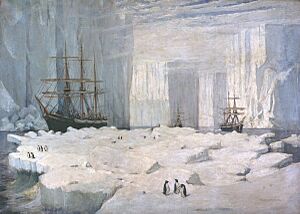Dundee Whaling Expedition facts for kids
The Dundee Whaling Expedition (1892–1893) was a journey from Scotland to Antarctica. Its main goal was to find whales for hunting. This trip was important for both science and business.
Contents
Why the Expedition Happened
Whaling in the Arctic Ocean was becoming difficult. This was because too many whales had been hunted there. Merchants in Dundee, Scotland, needed new places to find whales. They decided to send ships all the way to the Weddell Sea in Antarctica. They hoped to find many right whales there.
The Journey Begins
On September 6, 1892, four steam-powered whaling ships set sail. These ships were the Balaena, Active, Diana, and Polar Star. The crew faced a long and challenging voyage to the cold Antarctic waters.
What They Found
The expedition did not find the right whales they hoped for. The huge blue whales of the Antarctic were too strong and fast to be caught with their equipment. However, the expedition still made a profit. They did this by collecting many valuable seal pelts instead.
Important Discoveries and People
The expedition included important people who studied the polar regions. William Speirs Bruce was a polar scientist on the trip. William Gordon Burn Murdoch was a surgeon and assistant on the Balaena. He worked under Captain Alexander Fairweather.
On January 8, 1893, Captain Thomas Robertson of the Active made an important discovery. He found and named Dundee Island (63°30′S 055°55′W / 63.500°S 55.917°W). This island is located near the Antarctic Peninsula.
See also
- List of Antarctic expeditions
- Whaling in Scotland


